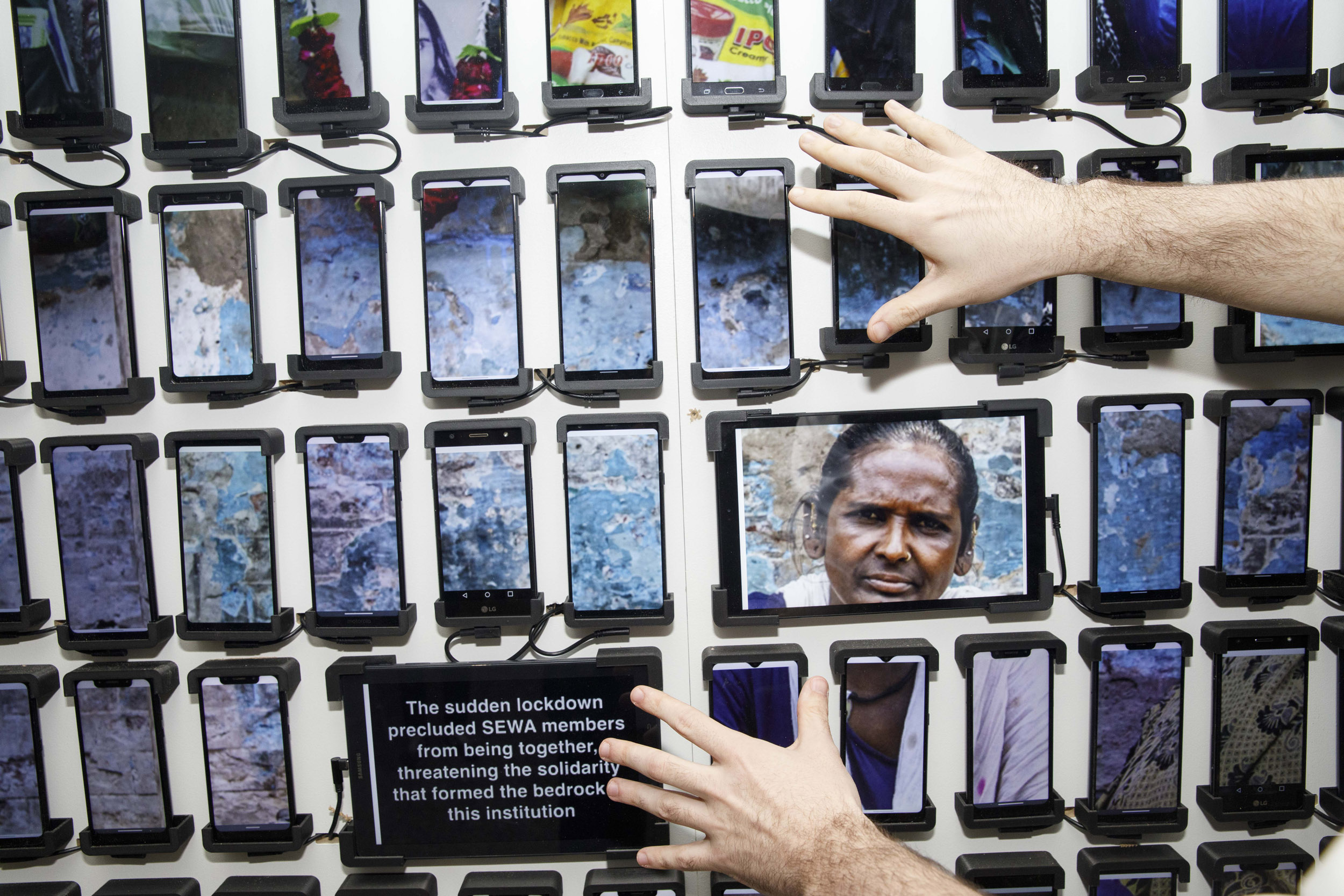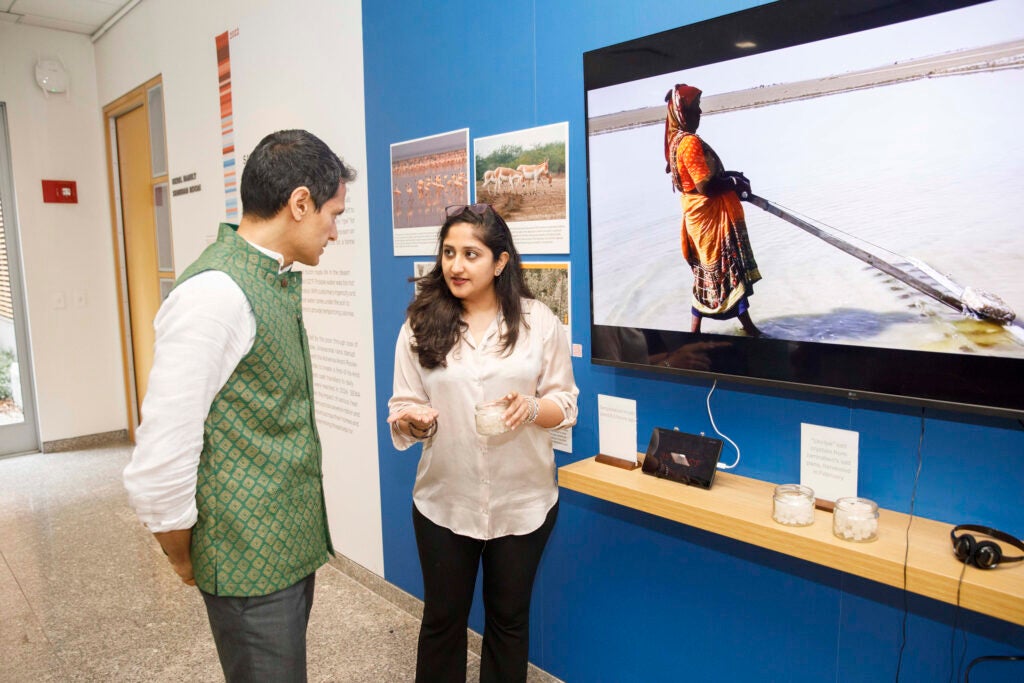
The team collected 30 hours of oral histories, filming many of the interviews with their smartphones.
Photos by Kris Snibbe/Harvard Staff Photographer
‘Tell the cities about us … and tell our neighbors about what we do’
‘HUM SAB EK’ harvests stories of self-employed Indian women’s hardships — and victories
Balancing “the trauma of the pandemic with the resilience” of India’s poor working women, Satchit Balsari, M.P.H. ’02, found a story of hope that now forms the basis of a stirring multimedia exhibit.
The journey to “HUM SAB EK — We Are One,” on view in CGIS South until Aug. 20, began in 2022, when Balsari, an associate professor in emergency medicine at Harvard Medical School and Beth Israel Deaconess Medical Center, undertook what could have been a routine assignment for a post-pandemic healthcare worker: researching the impact of the COVID-19 pandemic on India’s 2.9-million member Self Employed Women’s Association (SEWA).
“The story was not one of despair. It is about the power of these disadvantaged but very empowered women reaping the fruits of five decades of investments in their communities.”
Satchit Balsari
However, as he and his team began their interviews, they found themselves hearing about a lot more than lockdowns and lost wages. Armed with a questionnaire of “10 or 12” questions, Balsari expected the work to go quickly. “I found that I barely got through question two,” he recalled. “These women would talk extemporaneously, experientially, 45 minutes per question … And they’re just incredible stories.”
Ultimately, the team collected 30 hours of oral histories and surveyed 1,000 households, filming many of the interviews with their iPhones. Realizing that “this needs to be shared,” Balsari sought advice not only from his team but from the women they had interviewed. “They said, ‘Tell the cities about us and come to the villages and tell our neighbors about what we do,’” he recalled.
“HUM SAB EK” does just that, from its opening timeline, depicting SEWA’s 50 years of struggles and victories as well as the trauma and hardship of the pandemic. Sponsored by the Lakshmi Mittal and Family South Asia Institute, the exhibit begins with a photograph of SEWA members. The point, said Balsari, was that this was “a celebration because the story of SEWA was not one of despair.”

Immediately following this timeline is a giant tapestry, composed of pieces woven by textile workers in different regions of India. Although embroidery and weaving are largely done by independent home-based workers, the piece documents how quickly SEWA members turned from decorative work to mask-making in 2020. A white band in the piece represents “the three days when work stopped,” explained Balsari, before the workers pivoted. “These women had so much power over their decision-making,” he said, pointing out that 90 percent of households in India received masks woven and sewn by SEWA.
This is followed by a timeline of the pandemic in India, from the first case on Jan. 30, 2020, through its deadliest day, May 19, 2021, when 4,529 deaths (probably an undercount) were recorded. Placing this timeline down the stairs from the exhibit’s opening was intentional, explained co-curator Hiteshree Das, M.Des. ’25, who joined the project in 2023. Although the original study focused on COVID-19, the exhibit aimed to “set context for our audience here to understand what a trade union of informal working women do in India and how this 50 years of organizing has helped them better respond to disasters like the pandemic,” she said.
Charged with creating visual manifestations of the material, the GSD student knew her priority was keeping the members of SEWA front and center. “We wanted to make sure that their experiences were heard in their voices,” said Das.
To do this, the exhibit team made many of the interviews accessible, via videos that play continuously and interviews that can be accessed via headphones. To add visual interest, Das focused on specific elements of several of the stories. For example, under a video in which SEWA member Jamnaben Amarsinh talks about harvesting salt in the Rann of Kutch region, which has been severely impacted by climate change, we see samples of the salt in different stages of processing as well as a screen showing the current temperature in the salt flats.
To visually depict a court case SEWA filed during the pandemic to urge the construction workers’ welfare board to pay the workers their due, Das lined up earthenware gullaks, the traditional piggy banks in which families collect their savings. While these vase-like pots are graceful objects in their own right, having one sit on a stack of just some of the 500 pages of the court petition emphasizes “the tediousness of the bureaucratic procedures that citizens have to go through in order to demand what’s right,” said Das.
What comes across throughout the exhibit is the determination and spirit of the SEWA members, even as their struggle for basic human rights continues. That, said its curators, is the point.
“The story was not one of despair,” said Balsari. “It is about the power of these disadvantaged but very empowered women reaping the fruits of five decades of investments in their communities.”




